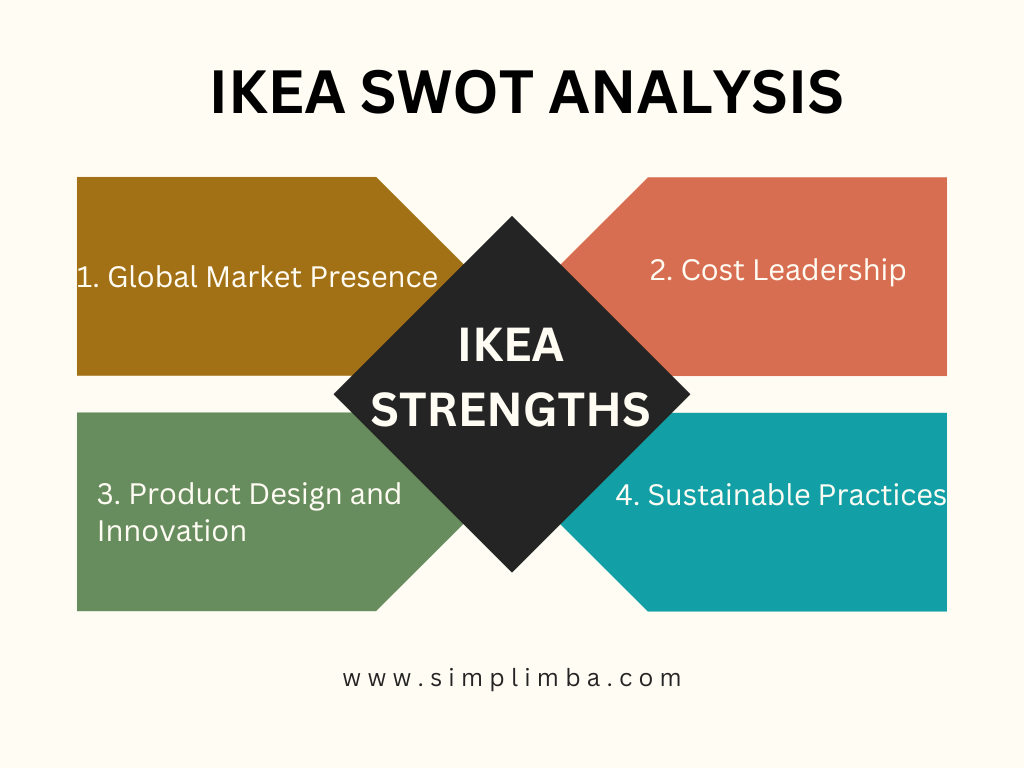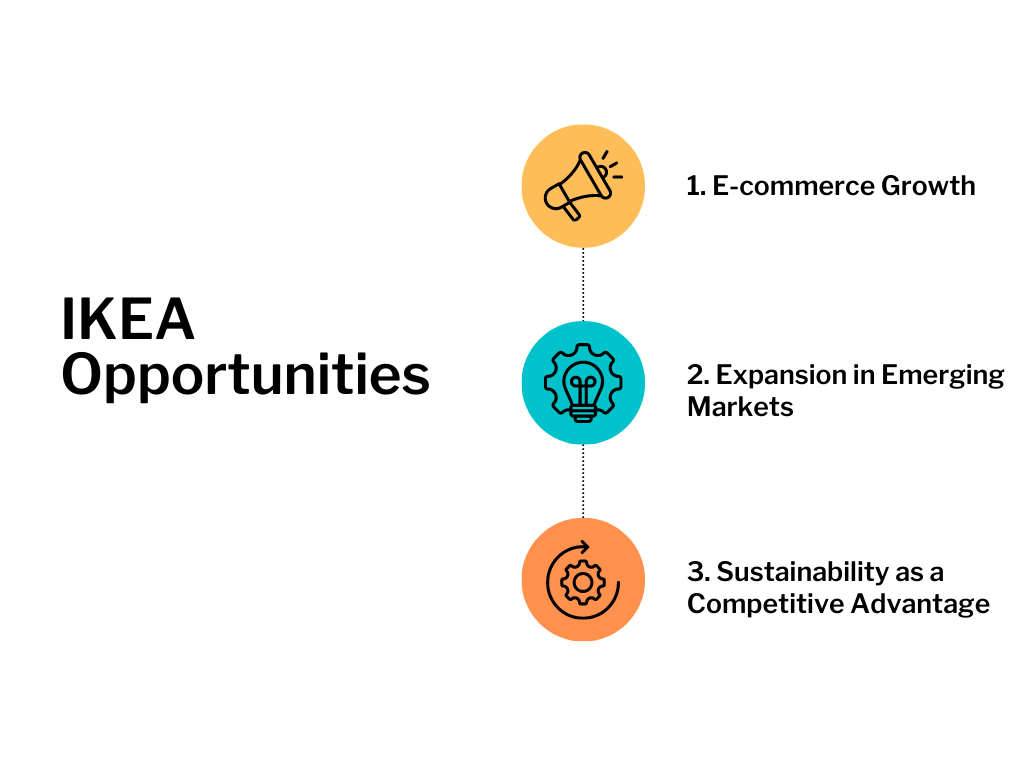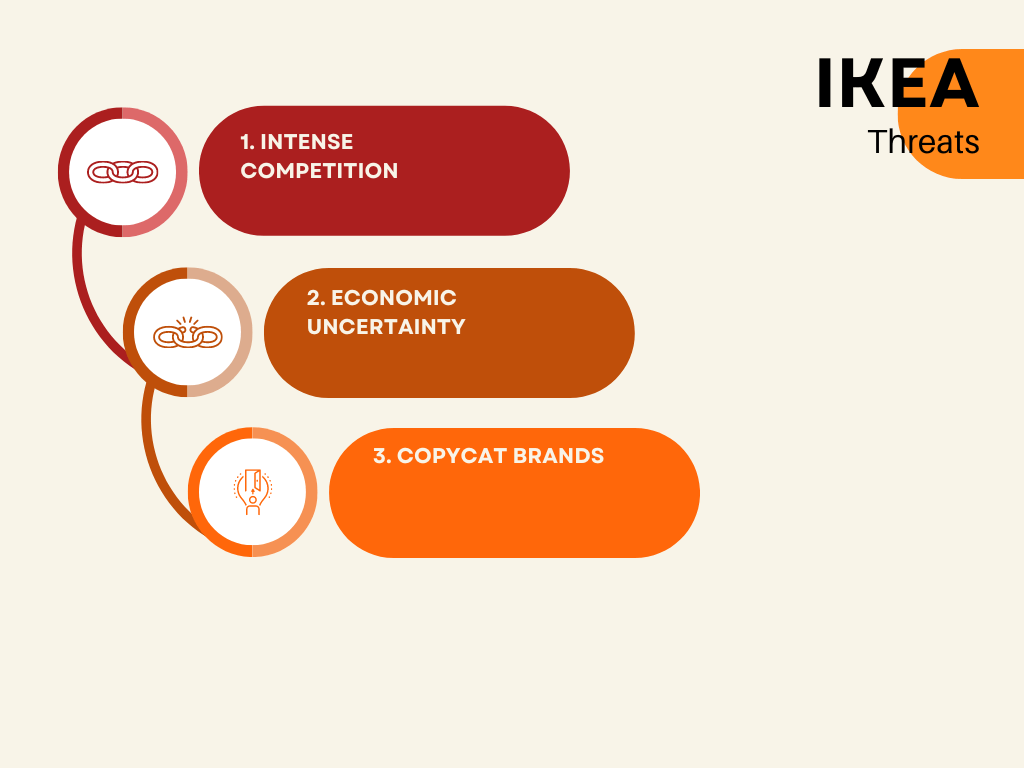Introduction
IKEA SWOT ANALYSIS: In the realm of home furnishing, IKEA has established itself as a global powerhouse, redefining the concept of affordable and stylish furniture. This Swedish retail giant has a unique business model that sets it apart from competitors, and it has continued to thrive over the years. To understand how IKEA has achieved such success, it is essential to conduct a thorough SWOT analysis, examining its strengths, weaknesses, opportunities, and threats.
IKEA SWOT ANALYSIS
IKEA Strengths

1. Global Market Presence:
IKEA’s global market presence is not only reflected in the number of stores but also in its market share. As of 2019, IKEA held approximately 33% of the US furniture market, solidifying its position as a dominant player. This market share allows for economies of scale, enabling-IKEA-to negotiate better deals with suppliers and maintain competitive prices.
2. Cost Leadership:
One of the key components of IKEA’s cost leadership strategy is its vertical integration. By owning various stages of the supply chain, including production facilities and forestry operations, IKEA reduces costs by cutting out middlemen. In addition, the company’s massive purchasing power gives it a significant advantage in negotiating lower prices from suppliers. These cost advantages are further amplified by efficient inventory management and logistics practices, allowing IKEA to pass on savings to customers.
3. Product Design and Innovation:
IKEA’s commitment to product design and innovation is evident in its vast range of products across different categories. The company invests heavily in research and development to create functional, stylish, and affordable furniture solutions. Moreover, IKEA’s flat-pack concept not only saves costs but also offers convenience for customers, enabling them to transport and assemble products easily. The company’s emphasis on innovative solutions has consistently garnered attention and resulted in numerous design awards and recognitions.
4. Sustainable Practices:
IKEA’s sustainability initiatives extend beyond its operations and supply chain. The company actively engages in partnerships with organizations such as WWF and UNICEF to promote sustainability and social responsibility. In terms of materials sourcing, IKEA aims to use renewable and recyclable materials, reducing its reliance on virgin resources. Additionally, the company implements energy-efficient measures in all stages of the product lifecycle, from production to transportation. By establishing itself as a leader in sustainability, IKEA not only aligns with consumer values but also gains a competitive advantage in a market increasingly driven by environmentally conscious buying behavior.
Additional Strength: Customer Loyalty Program
IKEA’s customer loyalty program, IKEA Family, contributes to its competitive advantage. This program offers various benefits, such as member discounts, extended warranties, free product insurance, and exclusive access to events and promotions. By nurturing a loyal customer base, IKEA can not only drive repeat purchases but also gather valuable customer data to enhance its marketing efforts and improve the overall shopping experience.
IKEA Weaknesses
1. Complex Store Layouts:
IKEA’s store layouts are intentionally designed to encourage customers to explore and engage with the products. However, the intricate maze-like layout can lead to inefficient navigation and difficulty finding specific items. This challenge is particularly pronounced during peak shopping periods, when crowds can further contribute to a confusing shopping experience. Streamlining the layout and providing clear signage can help alleviate this weakness and enhance customer satisfaction.
2. Criticisms Surrounding Quality:
While IKEA strives to offer products of good quality, some customers have expressed concerns about certain items’ durability and long-term performance. Improving quality control measures throughout the production process, enhancing product testing procedures, and adopting advanced manufacturing techniques can help address these concerns. Furthermore, investing in better packaging materials and providing clear instructions for assembly can minimize customer frustrations and enhance the overall perception of quality.
Additional Weakness: Limited Customization Options
One potential weakness for IKEA is the limited customization options available for its products. While the company offers a range of styles and configurations, customers who desire more personalized furniture choices may opt for competitors that provide greater flexibility. To address this weakness, IKEA can explore the introduction of customizable components or partnering with third-party vendors to offer additional customization options.
IKEA Opportunities

1. E-commerce Growth:
As the global e-commerce market continues to expand, IKEA has the opportunity to invest in its online channels and enhance the digital shopping experience. By leveraging technology, including augmented reality and 3D visualization tools, customers can virtually explore IKEA’s products and visualize them in their own spaces. Expanding e-commerce operations also allows IKEA to reach customers in geographically remote areas and adapt to changing consumer preferences for convenient and contactless shopping experiences.
2. Expansion in Emerging Markets:
Emerging markets, especially in Asia and Africa, present significant growth opportunities for IKEA. These regions are experiencing rising incomes, urbanization, and a growing middle class, leading to increased demand for affordable yet functional furniture solutions. By tailoring its product offerings, marketing campaigns, and store formats to meet the specific needs and preferences of consumers in these markets, IKEA can tap into new customer bases and establish a strong foothold.
3. Sustainability as a Competitive Advantage:
As consumers become more environmentally conscious, sustainability initiatives can serve as a powerful marketing and differentiation tool. IKEA can further amplify its sustainability practices by exploring innovative solutions, such as utilizing recycled materials in product manufacturing or adopting circular economy principles. Embedding sustainability into its brand strategy and effectively communicating these efforts to customers will position IKEA as a leader in environmental responsibility and attract consumers seeking authentic sustainable choices.
Additional Opportunity: Home Office Solutions
With the rise of remote work and the increasing number of people working from home, IKEA has the opportunity to develop and promote home office solutions. By offering a range of ergonomic furniture, innovative storage solutions, and efficient workspace designs, IKEA can cater to the evolving needs of customers in the post-pandemic era. Capitalizing on this trend can drive demand and stimulate growth in a rapidly expanding market segment.
IKEA Threats

1. Intense Competition:
IKEA operates in a highly competitive market, facing both traditional and online competitors. Established furniture retailers, online marketplaces, and niche players pose constant challenges to IKEA’s market share. To stay ahead, IKEA must continue to invest in research and development, product innovation, and marketing efforts that promote the unique value propositions of its brand.
2. Economic Uncertainty:
Global economic downturns, fluctuations in consumer spending patterns, and currency exchange rate fluctuations can adversely affect IKEA’s revenue. During times of economic uncertainty, consumers tend to defer non-essential purchases, impacting the demand for furniture. Adapting pricing strategies, new market penetration efforts, and diversification into ancillary services or product segments can help mitigate the risks associated with economic fluctuations.
3. Copycat Brands:
Given IKEA’s successful business model, it faces the threat of copycat brands seeking to replicate its success and undercut prices. These brands often focus on imitating IKEA’s designs and offering similar products at lower costs, eroding IKEA’s market share. To combat this threat, IKEA must continue to differentiate itself through a combination of unique product offerings, strong brand loyalty, and ongoing investment in design innovation.
Conclusion
With its global market presence, cost leadership strategy, product design excellence, and commitment to sustainability, IKEA has carved a distinct niche in the home furnishings industry. By addressing weaknesses related to complex store layouts, product quality, and customization options, IKEA can enhance its customer experience and maintain its competitive advantage. Furthermore, seizing opportunities in e-commerce growth, expansion in emerging markets, sustainability, and home office solutions will allow IKEA to drive future growth. Mitigating threats from intense competition, economic uncertainties, and copycat brands requires proactive measures and continuous innovation. As IKEA continues to leverage its strengths, address weaknesses, and adapt to changing consumer preferences, it will remain a globally recognized leader in the flat-packed furniture market
Samrat is a Delhi-based MBA from the Indian Institute of Management. He is a Strategy, AI, and Marketing Enthusiast and passionately writes about core and emerging topics in Management studies. Reach out to his LinkedIn for a discussion or follow his Quora Page

